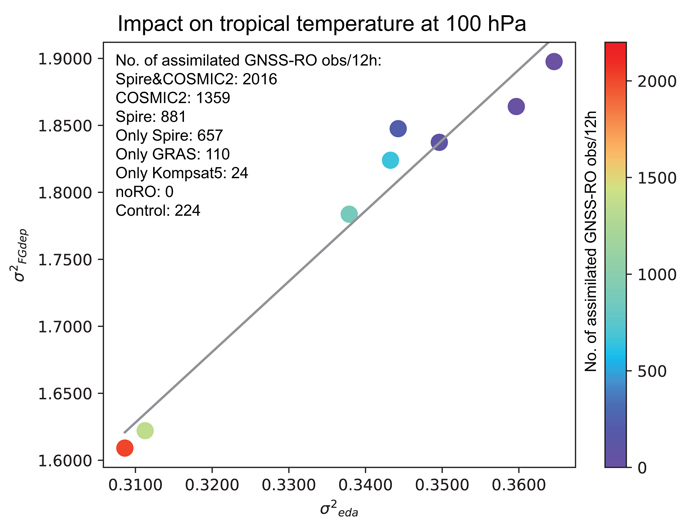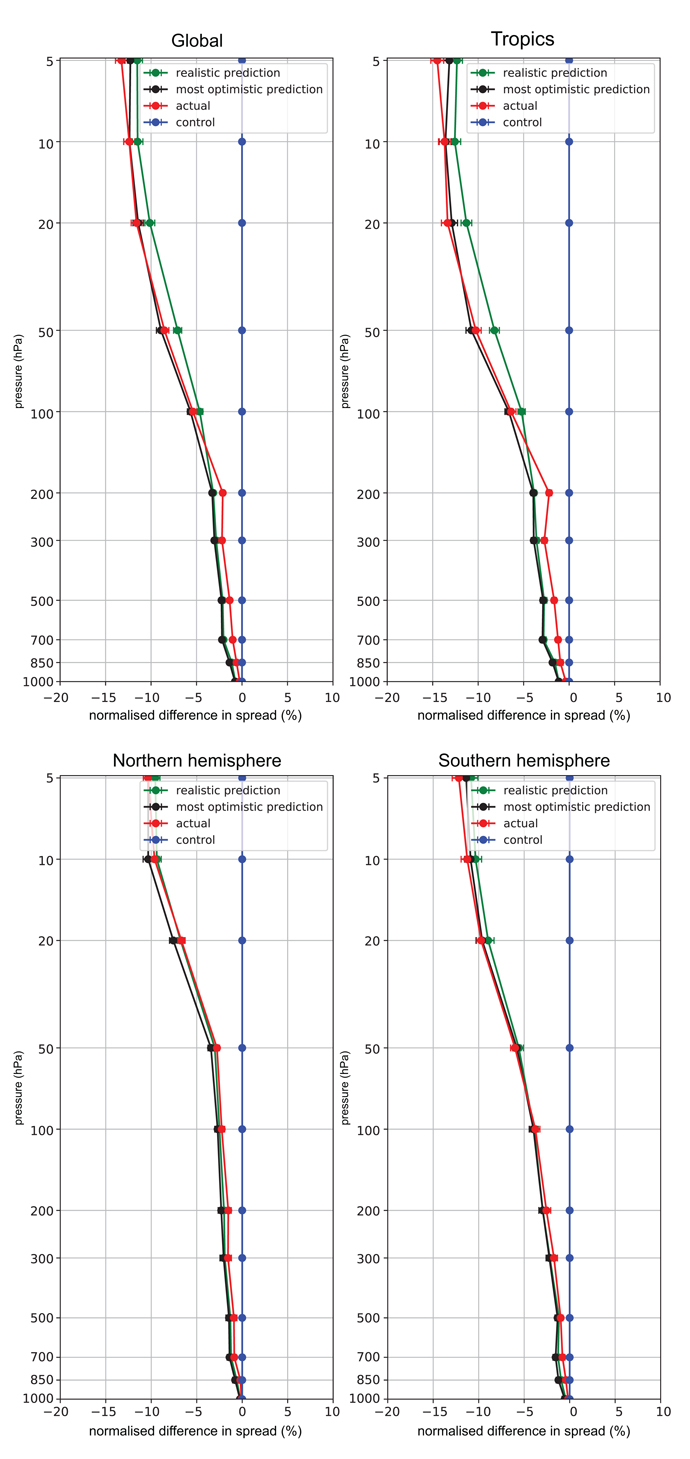

Sean Healy and Katrin Lonitz, Earth System Assimilation Section, Research Department
The importance of observations for numerical weather prediction (NWP)
The better we understand and measure the weather today, the more likely we are to produce good forecasts for tomorrow and beyond. This is because the computer models used to forecast the weather need an estimate of the 'initial conditions' of the atmosphere from which to start the computation with the NWP system. These initial conditions are often called the 'analysis' in meteorology, and they represent an optimal combination of a previous short-range NWP forecast and the most recent observations. The process of merging a previous forecast with recent observations is known as 'data assimilation'.
We currently assimilate over 40 million observations per day, and the vast majority of these now come from meteorological instruments on satellites, such as those provided by EUMETSAT and NOAA. That said, surface-based observations remain very important for NWP applications. The combined set of both surface- and space-based measurements available for weather and climate applications is referred to as the Global Observing System (GOS).
The various meteorological instruments on the satellites contribute a broad range of useful information to the analysis. Importantly, no single satellite instrument provides all the information we need for NWP applications, so finding the best GOS requires an appropriate mix of the different observing systems. For example, scatterometers can provide important information about wind speed and direction near the ocean surface, whereas AMSU-A microwave radiance measurements provide useful temperature information from the surface up to altitudes approaching 50 km. More generally, the World Meteorological Organization (WMO) maintains a database summarising the capabilities of both the surface-based and space-based components of the GOS. It also provides a vision for how the GOS should evolve out to 2040, and ECMWF is committed to supporting this work. But how do we assess whether proposed observation changes to the GOS are a good idea, before the new measurements are available?
Using an Ensemble of Data Assimilations (EDA) to assess the impact of observation changes in NWP
One method for testing proposed observation changes is to run observing system simulation experiments (OSSEs) (e.g. Errico and Privé, 2018). These are a massive computational undertaking. A high-resolution, state-of-the-art forecast model is run over an extended period to provide a nature run (NR), which is interpreted as a proxy for 'truth'. Then every existing observation system is simulated from this NR, and these synthetic observations are subsequently assimilated into an independent NWP system. The aim is to produce forecasts using the simulated measurements with similar error statistics to current operational NWP systems, noting that the NR provides a clearly defined truth. New observations can also be simulated from the NR, and assimilated alongside the existing data types, and so the impact of new data can be assessed.
ECMWF provides NRs to support OSSEs performed at other organisations (see this study for example), but we do not have the resources to simulate all the required data, and then perform the impact experiments with it. However, a few years ago David Tan and colleagues at ECMWF (Tan et al., 2007) suggested an alternative, simpler approach based on an Ensemble of Data Assimilations (EDA).
In an EDA, multiple data assimilation computations are run in parallel, but with perturbations added to the observations and other parameters, such as sea-surface temperature. If these perturbations are chosen appropriately, it can be shown that the 'spread' of the ensemble is related to the statistical uncertainty in the analysis and short-range forecasts. At ECMWF the main role of the EDA is to provide flow-dependent uncertainty information for the operational NWP system. Significantly, however, Tan et al. (2007) realised both real and simulated data could be included in the EDA at the same time. This means that we can assess how the new, simulated observations change the EDA spread, and this should indicate how they will reduce the statistical uncertainty in the analyses and short-range forecasts.
Using EDA to assess data from global navigation satellite system radio occultation (GNSS-RO)
GNSS-RO data are used at ECMWF to derive temperature and humidity profile information and have been assimilated into our forecasts since 2006. Their value for NWP is now generally established because they complement other observing systems, providing information with good vertical resolution that does not require bias correction to the NWP model.
We have used the EDA technique to estimate how the impact of information from GNSS-RO scales as the number of measurements increases (Harnisch et al., 2013). Surprisingly, in this study (supported by ESA) we continued to find a positive impact when increasing from 64,000 to 128,000 GNSS-RO observations per day, noting that we currently have around 9,000 occultations per day. A similar result has been obtained recently by Privé et al (2022) running GNSS-RO OSSEs.
The number of real GNSS-RO observations available for operational use has increased significantly in recent years with the introduction of COSMIC-2 data and access to Spire observations for selected periods. This has enabled us to revisit some of the work presented by Harnisch et al. (2013) as part of a new ESA study. In particular, we have looked at how the actual short-range forecast error statistics change as the number of GNSS-RO increases and compared it with the EDA spread reductions. One example is shown in Figure 1, for temperatures at 100 hPa in the tropics. As the number of GNSS-RO measurements increases, the short-range forecasts fit radiosonde temperature measurements more closely and the EDA spread values are reduced. However, it is noticeable that radiosonde departures are larger than the EDA spread values, and they tend to be reduced more than the EDA values as more GNSS-RO data is used. In summary, Figure 1 illustrates that there is a clear relationship between the quality of the short-range forecasts and the EDA spread on this level, as the number of real GNSS-RO measurements changes.

Figure 1: The variance of radiosonde short-range forecast departure statistics (σ2FGdep where FGdep = first guess departure) versus EDA variance (=spread squared, σ2eda) for temperature at 100 hPa in the tropics, as the number of GNSS-RO measurements is increased. GNSS-RO observations referred to: COSMIC-2, Spire, Kompsat5, GRAS.
Another interesting and reassuring new result is obtained when we compare EDA spread reductions computed from assimilating real and simulated COSMIC-2 GNSS-RO measurements (Figure 2). The real COSMIC-2 measurements are provided by UCAR. The simulated measurements have the same times and locations as the real UCAR data, but the measurement values use the simulation code developed in the Harnisch study and use ECMWF analyses. The agreement between the real and simulated COSMIC-2 data is quite impressive. The simulated data tends to give slightly larger reductions in spread in the troposphere, and slightly smaller reductions in the stratosphere, particularly in the tropics. These differences are still under investigation but appear to be related to the noise added to the simulated data. However, overall we believe that EDA calculations with simulated COSMIC-2 GNSS-RO data would provide a good estimate of the spread reductions to be expected with real data.

Figure 2: Comparing the EDA temperature spread reductions achieved with real COSMIC-2 measurements (red line) and simulated data (green line), with changes given as a percentage of the “control” experiment spread value. The black line is also for simulated COSMIC-2 data, but no errors have been added in the simulation process. The global statistics are computed for the ± 40 degree latitude band covered by COSMIC-2. The northern hemisphere, southern hemisphere and tropics plots cover: 20 to 40 degrees north; 20 to 40 degrees south and 20 degrees north to 20 degrees south, respectively.
Our colleagues Katie Lean and Niels Bormann are currently using the EDA techniques to assess the potential impact of new microwave measurements, and we have just started new Aeolus EDA activities to estimate the impact of improved Aeolus measurement error statistics.
Katie Lean talks about the use of EDA to investigate the impacts of satellite observations in NWP in studies funded by ESA and EUMETSAT.
ECMWF forecasts rely on the continued availability of high-quality observations, and it is important that we engage in ongoing discussions about how the GOS should develop and evolve. Predicting the impact of future observing system is a major challenge, but the EDA approach using simulated data is computationally affordable and we think it provides reliable guidance. In particular, recent results comparing the impact of real and simulated COSMIC-2 data in the EDA system are encouraging. Overall, we believe the EDA computations can help inform decisions regarding the future evolution of the GOS.
References
Errico, R.M. and Privé, N.C., (2018), Some General and Fundamental Requirements for Designing Observing System Simulation Experiments (OSSEs), WWRP 2018-8
Harnisch, F., Healy, S. B., Bauer, P., & English, S. J. (2013). Scaling of GNSS Radio Occultation Impact with Observation Number Using an Ensemble of Data Assimilations, Monthly Weather Review, 141(12), 4395-4413.
Lonitz K., Bowler N., Holm E. and Healy S. (2021), Assimilating Spire and COSMIC-2 data into the IFS, ECMWF Newsletter 169.
Lonitz, K., Marquardt C., Bowler N., Healy S. (2021), Final Technical Note of 'Impact assessment of commercial GNSS-RO data', ESA Contract Report.
Privé, N. C., Errico, R. M., and Akkraoui, A. E. (2022). Investigation of the Potential Saturation of Information from Global Navigation Satellite System Radio Occultation Observations with an Observing System Simulation Experiment, Monthly Weather Review, 150(6), 1293-1316.
Tan, D.G.H., Andersson, E., Fisher, M. and Isaksen, L. (2007), Observing-system impact assessment using a data assimilation ensemble technique: application to the ADM–Aeolus wind profiling mission. Q.J.R. Meteorol. Soc., 133: 381-390.
Banner image credit: ismagilov/iStock/Getty Images Plus
